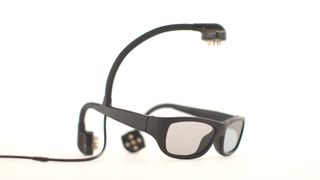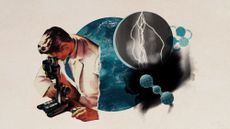Can these glasses read your mind? A look at the Wild West of brain gadgets.
When it comes to such gadgets, hope is ahead of science. But that need not deter explorers.


The headset I was wearing was supposed to be reading my brain.
Seated across from its inventor, I slid on the sleek wireless device, called Narbis Neurofeedback Glasses. A five-pronged sensor sat on my head, dark lenses shaded my eyes, and two arms hooked behind my ears. As I read a book, the lenses darkened and cleared, allegedly in sync with the drift of my attention.

Devon Greco, the 29-year-old founder of Narbis, wanted to make a brain-training device to help users focus. And unlike most biofeedback tools, his wireless glasses can be used far from a computer screen. Narbis recently raised $42,997 for its Neurofeedback Glasses in a Kickstarter campaign, and plans to sell the devices at $295 apiece. The glasses are being targeted at athletes and clinicians who treat ADHD, among others.
Subscribe to The Week
Escape your echo chamber. Get the facts behind the news, plus analysis from multiple perspectives.

Sign up for The Week's Free Newsletters
From our morning news briefing to a weekly Good News Newsletter, get the best of The Week delivered directly to your inbox.
From our morning news briefing to a weekly Good News Newsletter, get the best of The Week delivered directly to your inbox.
But do they really work?
Brain gadgets are becoming ever more popular, as techniques for stimulating or recording from the brain migrate from labs to the garages of do-it-yourself inventors like Greco. Neurofeedback tools like Narbis are one popular trend; "brain zappers" that use transcranial direct cortical stimulation, or tDCS, are another.
The much-hyped tDCS is a cautionary tale. The technique is supposed to ease everything from depression to hyperactivity to back pain by electrically stimulating the brain. But amidst hope and enthusiasm, many scientists and entrepreneurs have confused "claims with reality," as Dr. Vincent Walsh cautioned his colleagues in the journal Brain Stimulation. "We constantly sex up our findings for the press, and the result is an understandably overoptimistic public, because we — no one else — have misled them."
Despite a 2008 Harvard study suggesting that tDCS lessens pain, more recent research paints a different picture. In a recent analysis for Cochrane, a World Health Organization-affiliated NGO, Neil O'Connell and colleagues showed that the evidence that tDCS reduces back pain is overwhelmingly weak.
Sign up for Today's Best Articles in your inbox
A free daily email with the biggest news stories of the day – and the best features from TheWeek.com
Jared Horvath, a doctoral candidate at the University of Melbourne, used tDCS to study ADHD at Harvard for two years, without success, before deciding to investigate the tool itself. In a large meta-analysis of the brain zappers, he showed that few of the reported effects survive replication by multiple groups. The few that do are small effects that shrink over time, suggesting that the early positive results were misleading outliers.
As a 2012 paper pointed out, the sensationalization of biomedical devices often starts not with entrepreneurs, but with scientists, who spin reports of new discoveries.
"The scientist and the innovative entrepreneur have similar motivations," says O'Connell, a lecturer in physiotherapy at Brunel University in England. "They all want to discover something. Whether your vested interest is academic or entrepreneurial, there is an emphasis on discovery, but not on confirmation, not on rigorous replication."
Narbis' neurofeedback technology is based on work by Devon Greco's father, the late Domenic Greco. Domenic developed a patented brain-feedback device based on a NASA prototype that he used in psychotherapy with ADHD patients. A review of such neuro-feedback technology published last year in the journal Biological Psychology confirmed that the technique may work to reduce inattention, hyperactivity, and impulsiveness, but noted the small sample size and lack of placebo in many studies.
The review also addressed the "theta-beta ratio" on which Narbis' software is based, the measure of attention-related brainwaves developed by pioneering neurofeedback scientist Dr. Joel Lubar. According to research, this variable only affects 20 to 30 percent of ADHD children. So how the gadgets work remains unclear.
Narbis' marketing material, like that of many brain devices, makes claims both broad and specific. "By doing just two short training sessions a week, you can improve the overall performance of the brain," the website says. The company's promotional video adds, "Narbis can help you focus, sleep well, manage stress, and think clearly."
These claims are, of course, "falsifiable," as scientists say: testable hypotheses. But no such studies on the Narbis glasses have yet been done. The assertions are based on prior studies done by outside labs with similar setups, but not on the device the company is selling. The claims are, for now, more wishful marketing-speak than fact.
And while the FDA has approved commercial neurofeedback devices as safe (as long as they are not marketed to treat diseases), they don't have to meet any standard of effectiveness.
None of this means the device doesn't work, just that there is no way yet for consumers to know.
The problem, according to Brunel's O'Connell, starts with the bias toward positive results in science, along with hyperbolic terminology like "neuro-enhancement" and "brain boosting." New discoveries are published far more often than failures to reproduce previous results. These negative results, just as informative as successes, rarely see the light of day. Companies like Narbis have even less motivation to publish negative results.
"The things less incentivized are perhaps most important," O'Connell says. "When we [scientists] don't pay sufficient attention to the uncomfortable questions — low sample size, highly selected sample, loose exploratory statistics — then it isn't just the media who are responsible for hype."
"Of course, the idea of neurofeedback is incredibly intuitive and exciting, so it's no surprise that everyone wants to capitalize on it," says Todd Braver, an expert on cognitive control and a professor of psychology, neuroscience, and radiology at Washington University in St. Louis. "But we should be very wary of placebo effects — probably the most effective neurofeedback device there is: our belief system."
But that doesn't mean we should discourage companies like Narbis.
"I'm very happy for people to keep taking a crack at neurofeedback," says Braver. "That's what science is about anyway. What seem like crazy hare-brained ideas might actually work. But the main tenet of science is also: Show me the evidence. And we know what the history is with these 'neuroscience-inspired' products, software, gadgets: lots of claims and overblown arguments for support without really any direct evidence."
Taylor Beck is a writer based in New York. Come talk to him on Twitter.
-
 Scottish hospitality shines at these 7 hotels
Scottish hospitality shines at these 7 hotelsThe Week Recommends Sleep well at these lovely inns across Scotland
By Catherine Garcia, The Week US Published
-
 Scientists invent a solid carbon-negative building material
Scientists invent a solid carbon-negative building materialUnder the radar Building CO2 into the buildings
By Devika Rao, The Week US Published
-
 Crossword: April 1, 2025
Crossword: April 1, 2025The Week's daily crossword
By The Week Staff Published
